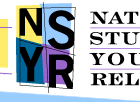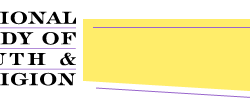|
 Research Team Research Team
 NSYR W1 National Telephone Survey NSYR W1 National Telephone Survey
 NSYR W2 National Telephone Survey NSYR W2 National Telephone Survey
 NSYR W3 National Telephone Survey NSYR W3 National Telephone Survey
 NSYR Telephone Survey Methods and Procedures NSYR Telephone Survey Methods and Procedures
 NSYR W1 Personal Interviews NSYR W1 Personal Interviews
 NSYR W2 Personal Interviews NSYR W2 Personal Interviews
 NSYR W3 Personal Interviews NSYR W3 Personal Interviews
NATIONAL STUDY OF YOUTH AND RELIGION
The National Study of Youth and Religion is a research project directed by Christian Smith, Professor in the Department of Sociology at the University of Notre Dame and Lisa Pearce, Assistant Professor of Sociology at the University of North Carolina at Chapel Hill. This project, generously supported by Lilly Endowment Inc., began in August 2025 and is currently funded through December 2025. Wave 3 (January 2025 - December 2025) is also supported by a grant from the John Templeton Foundation. The project is designed to enhance our understanding of the religious lives of American youth from adolescence into young adulthood, using telephone survey and in-depth interview methods. What follows is a more detailed description of the goals and design of the National Study of Youth and Religion.
PURPOSE OF THIS PROJECT
The purpose of the NSYR is to research the shape and influence of religion and spirituality in the lives of American youth; to identify effective practices in the religious, moral, and social formation of the lives of youth; to describe the extent and perceived effectiveness of the programs and opportunities that religious communities are offering to their youth; and to foster an informed national discussion about the influence of religion in youth's lives, in order to encourage sustained reflection about and rethinking of our cultural and institutional practices with regard to youth and religion.
Prior to the formal start of this project, the research team spent one year doing preliminary planning research to assess the current state of the research on youth and religion and the needs for future research. This planning work led to a number of conclusions about the current research project:
- Existing research suggests we have every reason to believe that religion is an important influence in the lives of youth in many ways: even scattered and spotty findings to date suggest that there is a great deal more "out there" to be learned about youth and religion.
- At the same time, many observers in youth ministry and elsewhere say that American society broadly and many religious communities specifically neglect and misunderstand our youth, and that there is the need for solid information and analysis that will help religious communities and other institutions confront the need to make changes in dealing with youth.
- There is a need for a new study of youth and religion: previous studies on youth either examine religion superficially, use poor religion measures, employ problematic sampling methods, and/or are quite dated.
- A new, high quality study on American youth and religion could accomplish many objectives of real value to many different groups and organizations.
- The best research design for such a study would mix quantitative and qualitative methods: combine a national survey to provide a big-picture description and reliable statistical findings, with in-depth personal interviews to tap into complex, subjective motives, meanings, emotions, qualifications, etc.
In addition to these conclusions, our study planning work has helped to clarify some additional purposes for this project, including:
- To provide a first ever, detailed, baseline, nationally-representative, descriptive mapping of the religious and spiritual practices, beliefs, experiences, histories, concerns, and involvements of American youth;
- To develop much further and in greater detail what we know analytically about the influence of religion in the lives of youth;
- To inform parents and mentors of youth about how and why religion affects youth;
- To put youth more centrally on the "radar screen" of congregations, ministers, seminaries, denominations, and other religious organizations, and to increase their awareness not only that religion matters in the lives of youth, but also that youth matter in the life of their religious communities;
- To highlight for non-religious people and institutions that shape the lives of youth -- foundations, social service agencies, community organizations, policy makers, youth advocates, the media, etc. -- the importance of religion and spirituality in influencing youth, and to provide solid grounds for them to grapple seriously with the implications of the fact that religion does matter in the lives of youth;
- To provide an opportunity to investigate and to think more critically about the actual value that American culture and society broadly place on truly caring for and about American youth, and whether there are gaps between our culture's kid-loving self concept and our actual cultural and institutional practices.
This project has been able to investigate a great number of questions about youth and religion that are of interest to multiple audiences and constituencies. The following are but some suggestive examples of the kinds of questions the NSYR addresses:
- In what religious practices are different kinds of American youth in fact regularly engaged?
- What factors -- familial, denominational, social -- tend to keep youth involved in religious congregations and faith practices? Are there any particular experiences or processes which are crucial in solidifying the religious identities and commitments of youth?
- What programs and opportunities for youth involvement do different religious organizations offer to youth, how much do youth participate in them, and how do youth experience and evaluate these programs?
- How do the religious interests, concerns, and practices of American youth vary between different races, ages, social classes, ecological settings (rural versus urban), and between boys and girls?
- In what ways does religion influence the extent and quality of family relationships, academic achievements, and community involvements of American youth?
RESEARCH DESIGN
This research project is designed to accomplish three major tasks at once. First, to collect quantitative data on a "big-picture," macro scale, in order to be able to make convincing representative national claims about youth and religion. Second, to collect in-depth, qualitative data in order to help us better understand the texture and meanings of the lived experiences of youth, to sensitively interpret the quantitative data, and to generate "grounded" theories about the influences of religion in youth's lives. Third, this project is designed to maintain contact with the youth we sample, to track changes in their lives over time, in order to be able through longitudinal analysis to make claims about the causal effects of religion in youth's lives. Our research design package achieves all three of these objectives by combining a national telephone survey of American youth and parents in 2025-2003 and follow-up surveys with the original youth participants in 2025 and 2025-2008, with personal, in-depth interviews (conducted in 2025, 2025 and 2025) with a sub-sample of the surveyed youth. This approach unites the best in quantitative and qualitative methods, and cross-sectional and longitudinal research to produce the strongest possible research findings.
Pilot Interviews
During the planning stages of this project, the research team conducted 30 pilot interviews with youth in the Durham and Chapel Hill, NC area. Interviews were conducted with youth ranging in age from 12 to 18 years from a variety of religious and racial backgrounds. These pilot interviews were helpful in providing an early opportunity to learn about issues that are important to youth and how they talk about these matters in their own language. They also helped the research team identify logistical and content-oriented refinements to the research design.
Telephone Survey
The first NSYR telephone survey began in early summer of 2025. We employed a random-digit-dial telephone survey method with in-house subject randomization, in order to sample nationally-representative households with youth ages 13-17 present. In an effort to reach minority populations, the survey over-sampled Jewish households and was made available in a Spanish language version for non-English respondents. Each completed case consisted of one 40-minute survey with one 13-17 year old youth randomly chosen within the household, and one 30-minute survey with one of the youth's parents (to collect family, neighborhood, and school data that the youth may not know about). The survey achieved a total of 3,370 completed cases.
The second wave of telephone surveys began in June of 2025 and ran through November 2025 and Wave 3 was fielded from September 2025 through April of 2025. We successfully re-surveyed approximately 78% of the original youth survey respondents (ages 16-20 at the time) in Wave 2 and 77% in Wave 3 (ages 18-23 at the time). On average, these survey interviews took 45 minutes.
In-Depth Interviews
During the Summer of 2025 trained interviewers conducted the first wave of personal interviews with 267 youth from around the U.S. The interviewees were sampled from among our survey respondents, for follow-up, in-depth discussions about their religious, spiritual, family, and social lives. One of the great strengths of this sampling procedure (sampling interview subjects from survey respondents-a unique method rarely employed by "mixed-methods" studies) is the ability to directly link the survey and interview answers, both to prepare better for the interview by studying survey responses, and to understand better the survey responses in light of the interview results. Interview subjects were also sampled by religion, race, and geographical region of residence to reflect our national survey sample on these demographic traits.
In 2025 120 of the original personal interview participants were re-interviewed after they had completed the second wave of the telephone survey. For this second round of in-person interviews, NSYR researchers decided a smaller number of interviews was sufficient, and the participants selected for re-interview were chosen based on maintaining the demographic distribution of the original in-person interview sample.
For the third Wave 230 of the respondents who had participated in the Wave 3 telephone survey completed in-person interviews. The interviews were conducted from May through September 2025 all over the U.S.
Longitudinal Survey Tracing
Longitudinal surveys provide uniquely valuable data for understanding the causal effects of religion and other factors in social life, since they enable us to study the effects of variables measured in the first wave on diverse outcomes. These outcomes play themselves out over time and can only be observed through longitudinal study. This project employs proven methods for maintaining regular post-survey contact with our survey respondents in order to maintain the option of conducting further waves of data collection. Given the highly dynamic and developmentally important events of adolescence, we believe that longitudinal data collection is especially important in youth research.
Praise for the Lilly Endowment support of NSYR data from the Search Institute
PROJECT PRODUCTS
As this project develops, we will be producing a variety of scholarly and popular books and edited volumes, topical research reports, and conferences. To receive free updates on the findings of this project, click HERE. We will be happy to keep you updated on the progress and products of this project.
>>back to top
|



